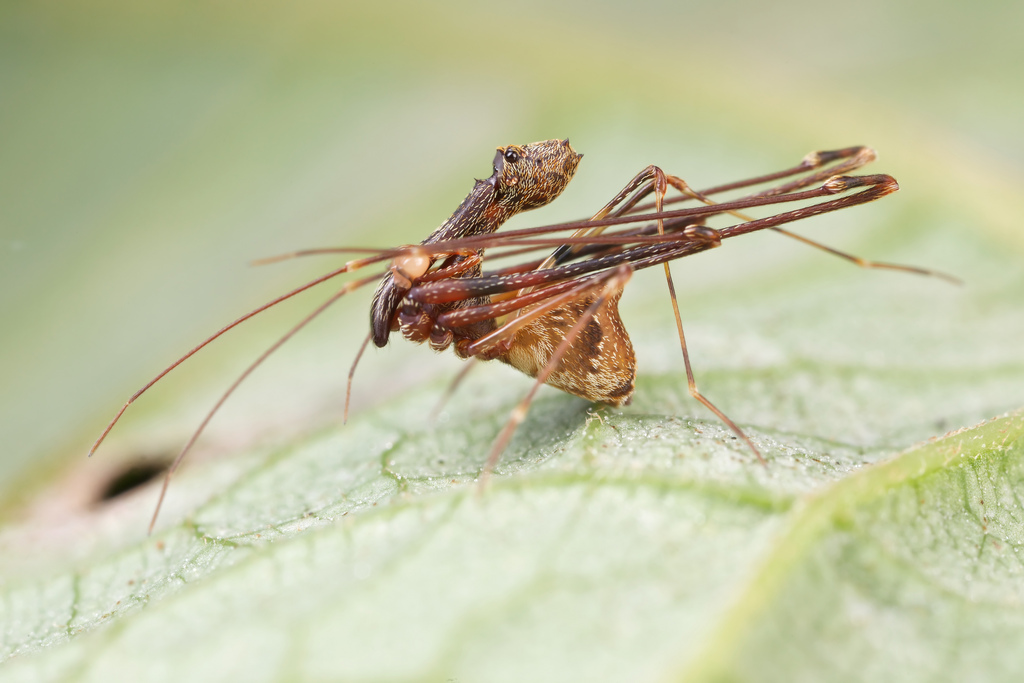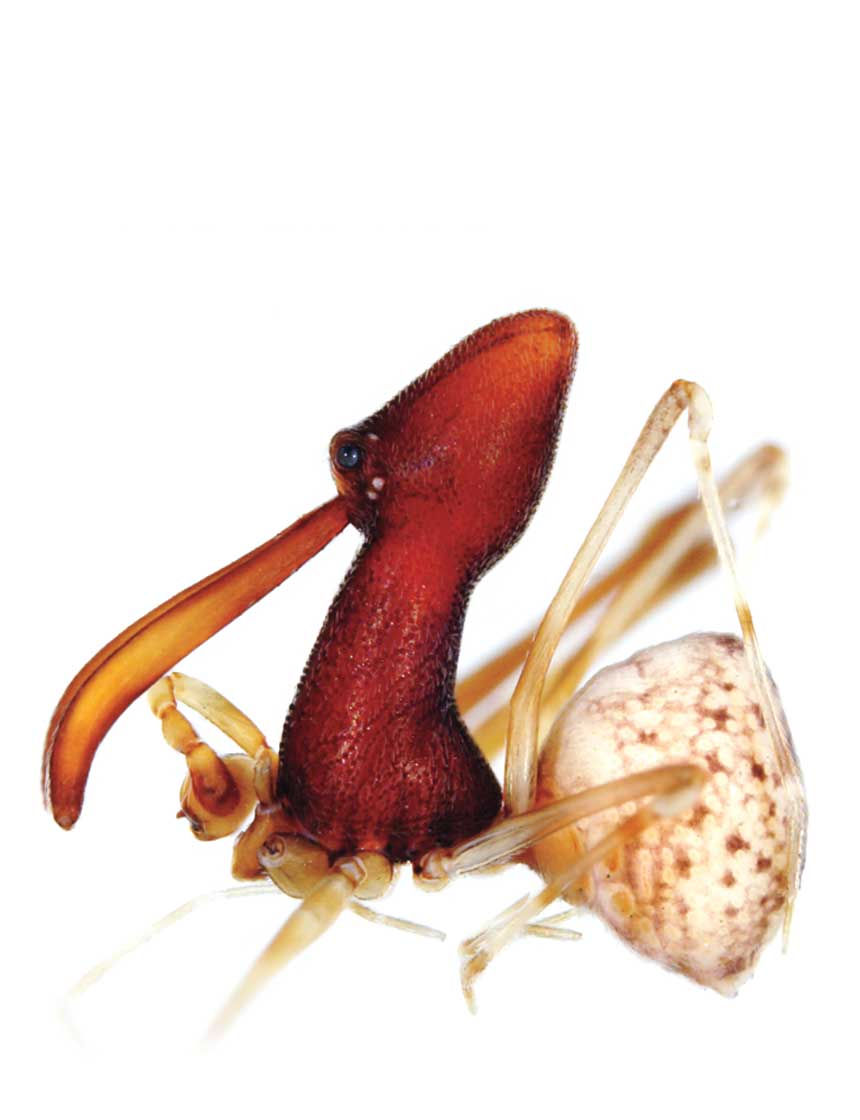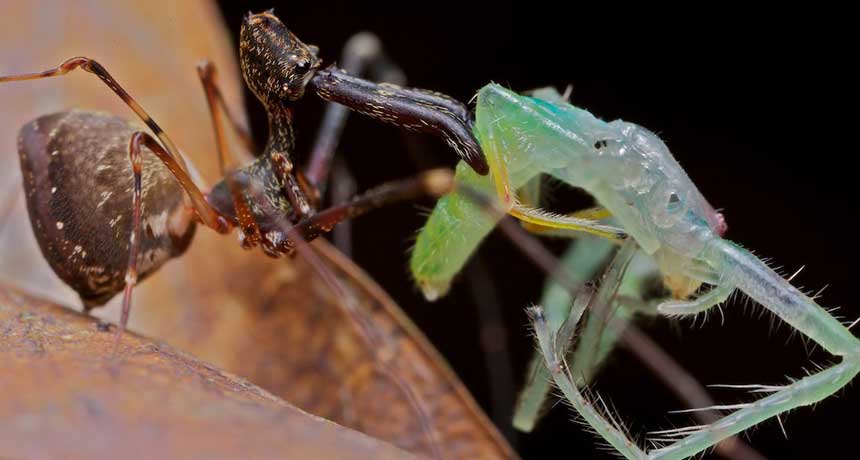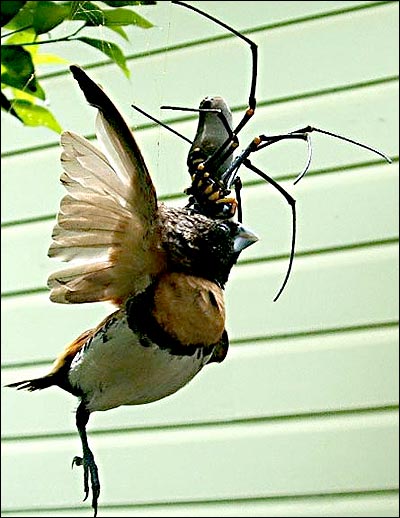It looks like you're using an Ad Blocker.
Please white-list or disable AboveTopSecret.com in your ad-blocking tool.
Thank you.
Some features of ATS will be disabled while you continue to use an ad-blocker.
5
share:

Photo taken in Andasibe national park, Madagascar.

What a beauty eh?
Ran across this today and thought I would share it. I have never heard of this spider and it's bizarre look and shape makes it so unique. It is amongst a class of spiders known as assassination spiders, in that they prey on other spiders.
These critters are the size of a grain of rice. Such odd features, yet another mondo bizzaro species.

It’s a distance of only a few millimeters. But that’s substantial for these teensy dramas, and enough space to let a group called pelican spiders bring down their wary and dangerous prey: other spiders.
The pelican name comes from their profiles. “They look like little birds,” says Hannah Wood of the University of California, Davis. The spider’s body is about the size of a grain of rice, with a front segment that has evolved into a stretched “neck” with a little round “head” on top. (The mouth is actually at the bottom of the “neck”). And a pair of jawlike fanged projections called chelicerae folds down against the neck, where a pelican would tuck its beak.
Pelican spiders don’t build webs. Instead they creep through foliage, tiptoeing upside down under leaves to hunt. A female will carry her eggs with her, in a silk bag she attaches to one leg in the third of her four pairs. The spiders’ back six legs do the walking while the front two sweep circles in the air feeling for prey. A pelican spider that picks up the silk trail of another spider will spend hours at the edge of that spider’s web, plucking now and then and waiting. Unlike the quick spiders you might see skittering up a garden shed wall, Wood says, stalking pelicans are “slow and deliberate.”
But when they strike, it’s fast. The jawlike chelicerae rise 90 degrees and then slam fanged tips into the prey. “Then they pull out one chelicera and leave the other one hanging out there with the spider prey impaled on it,” Wood says.
Next it’s just a matter of waiting for the venom to work. Thanks to the pelican spider’s long neck and chelicerae, its prey struggles at a harmless distance.
Attacking at jaw’s length is an ancient trick. Biologists first discovered extinct pelican spiders in fossils before realizing the family still lives (in Madagascar, South Africa and Australia). Today’s species split off on their own trajectory as the supercontinent Pangaea was breaking up some 180 million years ago, Wood and her colleagues reported last year in Systematic Biology.
www.sciencenews.org...
More
Wow, lancing beak like jaws! Now I know where some influence for the creatures in Starship Trooper may have come from.
Oh mother nature, you never cease to amaze!
spec
reply to post by speculativeoptimist
Beautiful. Another great example of the rich diversity that is found on this pla-. . . . .
It's a spider?

Beautiful. Another great example of the rich diversity that is found on this pla-. . . . .
It's a spider?

You've gotta be a dumb insect to get caught surely.....?.
Fruit fly - buzzing around...... Ah, look at the beautiful pelican....... Do you know that pelicans exists in a Madagascan acidic lake and are coloured pink because......... Hang on, were in Borneo and that ain't a Pelic..........CHOMP."
PDUK
Fruit fly - buzzing around...... Ah, look at the beautiful pelican....... Do you know that pelicans exists in a Madagascan acidic lake and are coloured pink because......... Hang on, were in Borneo and that ain't a Pelic..........CHOMP."
PDUK
Now, if my daughter still hates spiders after seeing this one, and keeps on wishing to meet Rachnids instead, nothing will change her mind.
So cute! Even better than CATS!!!
So cute! Even better than CATS!!!
reply to post by beezzer

Aw c'mon Beez, it's the size of again of rice. You probably wouldn't even notice it's beak plunging into your skin.
Thanks for the chuckle!

Aw c'mon Beez, it's the size of again of rice. You probably wouldn't even notice it's beak plunging into your skin.
Thanks for the chuckle!
edit on 13-3-2014 by speculativeoptimist because: spelling
speculativeoptimist
reply to post by beezzer

Aw c'mon Beez, it's the size of again of rice. You probably wouldn't even notice it's beak plunging into your skin.
Thanks for the chuckle!edit on 13-3-2014 by speculativeoptimist because: spelling
SnF
It is a beautiful example of the diversity of nature.
But it is still a spider.
*shudder*
reply to post by PurpleDog UK
Too funny PD! The spider community probably already knows and teaches their young to never sit still and admire a pelican, instead use those eight legs and RUNNNNN!
Too funny PD! The spider community probably already knows and teaches their young to never sit still and admire a pelican, instead use those eight legs and RUNNNNN!
reply to post by speculativeoptimist
S&F Op! Very interesting.
Still convinced spiders are from space. Super intelligent, alien a#holes.
Except for jumping spiders. They're the puppies of the arachnid kingdom. That and they have a sense of humor.
S&F Op! Very interesting.
Still convinced spiders are from space. Super intelligent, alien a#holes.
Except for jumping spiders. They're the puppies of the arachnid kingdom. That and they have a sense of humor.
I'm afraid I'm with beezer. While it is very unique, cool, all that, it's still a spider. Thankfully for this type, it is not in my area, which
means it won't die by my hand. (or whatever is handy to smoosh it)
Still, thanks for showing me something new, even if it may give me nightmares.
Still, thanks for showing me something new, even if it may give me nightmares.
reply to post by Lynx1102
So you are saying if late one night you are laying in bed and a jumping spider lands on your arm you would not freak out a bit?
They are harmless though, as you know, and like the grandaddy long legs have amused kids for years.
Now this thing on the other hand

yikes!!
So you are saying if late one night you are laying in bed and a jumping spider lands on your arm you would not freak out a bit?
They are harmless though, as you know, and like the grandaddy long legs have amused kids for years.
Now this thing on the other hand


yikes!!
edit on 13-3-2014 by speculativeoptimist because: (no reason given)
reply to post by speculativeoptimist
I like spiders they way they normally look. It freaks me out if a spider looks like a pelican. That said, I think that nature's diversity is definitely amazing. Thanks for opening our mind.
I like spiders they way they normally look. It freaks me out if a spider looks like a pelican. That said, I think that nature's diversity is definitely amazing. Thanks for opening our mind.
reply to post by Lynx1102
I totally agree with you! Spiders ARE from space.They are creepy and dangerous and mean and,and,and. Well you get the picture.No spiders for me please.I don't want to be taken up in their space ships.
I totally agree with you! Spiders ARE from space.They are creepy and dangerous and mean and,and,and. Well you get the picture.No spiders for me please.I don't want to be taken up in their space ships.
reply to post by Tylerdurden1
Here try this one for better dreams:
Here try this one for better dreams:
edit on 14-3-2014 by speculativeoptimist because: (no reason given)
new topics
-
Merry Christmas !!
General Chit Chat: 24 minutes ago -
This is an interesting picture. Do we actually pick our leaders?
Politicians & People: 11 hours ago
top topics
-
University looking for gender diverse kids to play with transgender dolls for research
Social Issues and Civil Unrest: 16 hours ago, 9 flags -
This is an interesting picture. Do we actually pick our leaders?
Politicians & People: 11 hours ago, 9 flags -
Trump says ownership of Greenland 'is an absolute necessity'
Other Current Events: 14 hours ago, 8 flags -
U.S. Govt Agencies That Protect Criminals in Government - National Archives Records Admin-NARA.
Political Conspiracies: 12 hours ago, 6 flags -
FAA Investigates Christmas Drone Show Gone Wrong in Orlando, FL 12/2024
Other Current Events: 16 hours ago, 5 flags -
An Updated China Navy Analysis and the Challenges of their AI/Drone Development
Military Projects: 15 hours ago, 4 flags -
Merry Christmas !!
General Chit Chat: 24 minutes ago, 1 flags
active topics
-
Biden Nationalizes Another 50,000+ Student Loans as He Heads for the Exit
US Political Madness • 21 • : Skinnerbot -
Spiritual Solstice
Short Stories • 16 • : Naftalin -
Merry Christmas !!
General Chit Chat • 1 • : SteamyAmerican -
California Business Owners Blindsided by Surprise Payroll Taxes
US Political Madness • 15 • : Dalamax -
This is an interesting picture. Do we actually pick our leaders?
Politicians & People • 7 • : confuzedcitizen -
-@TH3WH17ERABB17- -Q- ---TIME TO SHOW THE WORLD--- -Part- --44--
Dissecting Disinformation • 3794 • : brewtiger123 -
U.S. Govt Agencies That Protect Criminals in Government - National Archives Records Admin-NARA.
Political Conspiracies • 6 • : confuzedcitizen -
Can we be certain that Jesus Christ was born on December 25th?
Religion, Faith, And Theology • 31 • : confuzedcitizen -
Australian mercenary caught and crying as he is a prisoner of war.
Other Current Events • 42 • : confuzedcitizen -
JILL BIDEN Wants JOE to Punish Democrats Who Forced Him to Leave Office in Disgrace on 1.20.2025.
2024 Elections • 13 • : confuzedcitizen
5
